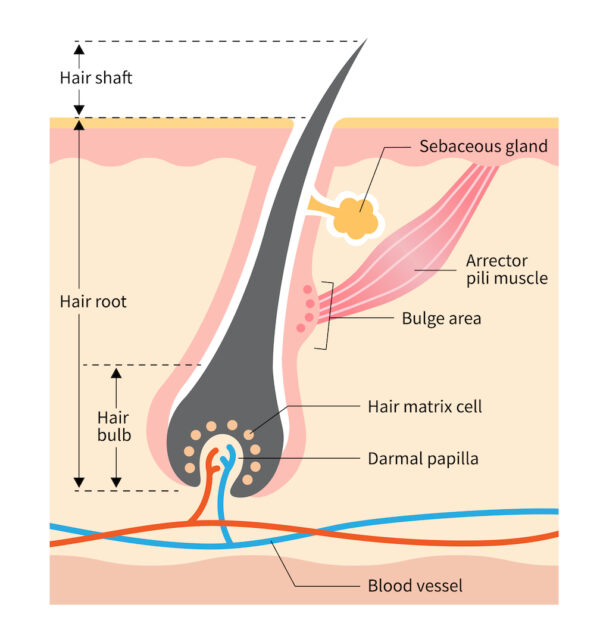Breakthrough Study May Reveal the Root Cause of Gray Hair
A new animal study suggests that certain stem cells have the unique ability to move between the growth zones of hair follicles. However, as we age, these stem cells become stuck and lose their ability to mature and maintain hair color. This discovery potentially opens up new opportunities for scientists to explore natural approaches to delaying the onset of gray hair.
Why Does Hair Turn Gray?
Have you ever wondered exactly why our hair turns gray as we get older? Although we have a variety of hair colors during our youth, once we age, our hair inevitably turns the same color.
The natural color of our hair is determined by a pigment called melanin, which is produced by melanocytes, cells located at the base of hair follicles. They produce two types of melanin: eumelanin, which is responsible for brown or black hair, and pheomelanin, which creates blond or red hues. The balance between these two types of melanin determines the final color of our hair.
As we age, the production of melanin decreases, and the concentration of melanin also decreases, leading to the graying of our hair.
However, the exact mechanism behind the decrease in melanin production remains a mystery.
‘Stuck’ Melanocyte Stem Cells May Be the Reason for Hair Graying
Melanocytes are derived from melanocyte stem cells, which have a self-renewal ability. Each hair follicle has two stem cell compartments, including the bulge area and the hair germ. Both store melanocyte stem cells for later use during the growth of new hairs.

A recent study in mice published in the journal Nature showed that melanocyte stem cells have high mobility and move frequently between the compartments of hair follicles during normal hair growth. In these compartments, the stem cells are exposed to different levels of protein signals that influence their maturity. As the hair ages, sheds, and repeatedly grows back, more and more of these stem cells become trapped in the compartment known as hair follicle bulge, preventing them from maturing into pigment cells. They no longer travel back to the germ compartment, where the maturity-influencing proteins would have stimulated their regeneration. As a result, the hair continues to grow without the pigment, turning gray.
During our lifetime, this hair lifecycle is repeated 10 to 20 times. However, the Nature study indicates that as we age, an increasing number of melanocyte stem cells become unable to translocate between the hair follicle’s stem cell and transit-amplifying compartments. Instead, they get stuck in the bulge, where there is no Wnt signal to stimulate their maturation. The Wnt pathway is an important player in influencing cell fate decisions.
“These findings suggest that melanocyte stem cell motility and reversible differentiation are key to keeping hair healthy and colored,” said Mayumi Ito, who earned her doctorate at Nagoya University, in a press release. Ito is a professor in the Ronald O. Perelman Department of Dermatology and Department of Cell Biology at New York University Langone Health, as well as a senior investigator on the study.
The research team also repeatedly plucked hairs from the mice for two years to speed up hair regeneration. The result was an increased number of stem cells in the follicle bulge. The mice’s hair follicles containing dormant bulge melanocyte stem cells increased from 10 percent to over 50 percent. Therefore, repeated plucking (i.e., “forced” aging) of hairs can lead to a faster accumulation of stranded melanocyte stem cells, which are unable to produce pigment, and the mice’s hairs turn gray faster.
The researchers intend to use these findings to further explore methods for restoring the mobility of melanocyte stem cells or transferring them back to the germ compartment, allowing them to reproduce pigment, according to Ito.
Other Theories Regarding Hair Graying
It was previously believed that follicular melanocyte stem cells remained in a dormant and undifferentiated state in the bulge.
One theory of hair graying is the free radical theory, which suggests that oxidative stress can accelerate the aging process and contribute to hair graying. During hair’s active growth phase, which is when the hair shaft is formed, continuous melanin production in the hair follicle can generate high oxidative stress. Melanocyte cell death and increased oxidative stress have been found in graying hair follicles.
Furthermore, a European study published in the FASEB Journal has shown that hydrogen peroxide-induced oxidative damage is a key factor in hair graying. The hair follicle produces small amounts of hydrogen peroxide from melanogenesis, which accumulates on the hair shaft. Although low concentrations of hydrogen peroxide increase the activity of tyrosinase, a key enzyme in melanin production, high concentrations can deactivate the enzyme, leading to a gradual loss of hair color.
Other factors that may contribute to hair graying include smoking, genetics and certain medical conditions, stress, exposure to chemicals, and nutrient deficiency.




